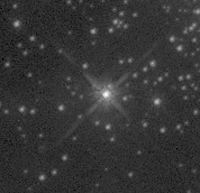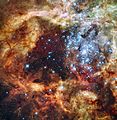Melnick 34 facts for kids
| Observation data Epoch J2000.0 Equinox J2000.0 |
|
|---|---|
| Constellation | Dorado |
| Right ascension | 5h 38m 44.26s |
| Declination | −69° 06′ 05.88″ |
| Apparent magnitude (V) | 13.09 |
| Characteristics | |
| Evolutionary stage | Wolf–Rayet star |
| Spectral type | WN5h + WN5h |
| B−V color index | +0.25 |
| Astrometry | |
| Radial velocity (Rv) | 287±5 km/s |
| Distance | 163,000 ly (49,970 pc) |
| Absolute magnitude (MV) | -7.42 |
| Orbit | |
| Period (P) | 154.55±0.05 d |
| Eccentricity (e) | 0.68±0.02 |
| Inclination (i) | ~50° |
| Periastron epoch (T) | 57671.2±0.9 JD |
| Argument of periastron (ω) (secondary) |
20.9±3.8° |
| Semi-amplitude (K1) (primary) |
130±7 km/s |
| Semi-amplitude (K2) (secondary) |
141±6 km/s |
| Details | |
| A | |
| Mass | 148 M☉ |
| Radius | 19.3±2.8 R☉ |
| Luminosity | 2,042,000 L☉ |
| Temperature | 53,000±1,200 K |
| Age | 0.5±0.3 Myr |
| B | |
| Mass | 135 M☉ |
| Radius | 18.2±2.7 R☉ |
| Luminosity | 1,585,000 L☉ |
| Temperature | 53,000±1,200 K |
| Age | 0.6±0.3 Myr |
| Other designations | |
|
BAT99 116, [HSH95] 8, Melnick 34, 2MASS J05384424-6906058, Brey 84
|
|
| Database references | |
| SIMBAD | data |
BAT99-116, also known as Melnick 34 or Mk34, is a fascinating binary star system. This means it's made of two stars orbiting each other! These stars are a special type called Wolf-Rayet stars.
You can find BAT99-116 in the Tarantula Nebula, a huge cloud of gas and dust where new stars are born. This nebula is part of the Large Magellanic Cloud, which is a small galaxy near our own Milky Way. Both stars in BAT99-116 are among the biggest and brightest stars we know! They are so powerful that they glow with X-rays.
Contents
Discovering BAT99-116
Astronomers first spotted this amazing star system a while ago. It's listed in different star catalogs under names like BAT99-116 and Melnick 34. Scientists use powerful telescopes to study stars like these. They learn about their size, brightness, and how they move.
Where to Find It
BAT99-116 is located in the Dorado constellation. This constellation is in the southern sky. You can't see it without a telescope because it's so far away. It's about 163,000 light-years from Earth!
What Makes These Stars Special?
The stars in BAT99-116 are both Wolf-Rayet stars. These are very rare and super hot stars. They are much bigger and brighter than our Sun.
Massive and Bright Stars
Each star in the BAT99-116 system is incredibly massive.
- One star has about 148 times the mass of our Sun.
- The other star has about 135 times the mass of our Sun.
They are also incredibly bright!
- The first star shines with the power of over 2 million Suns.
- The second star shines with the power of over 1.5 million Suns.
These stars are very young, only about half a million years old. Our Sun is about 4.6 billion years old, so these stars are just babies in space terms!
How They Orbit Each Other
Since BAT99-116 is a binary system, its two stars orbit around a common center.
- They complete one orbit every 154.55 days, which is about five months.
- Their orbit is not a perfect circle; it's more of an oval shape. This is called an eccentric orbit.
Scientists study their orbit to learn more about how these giant stars interact.
Images for kids



